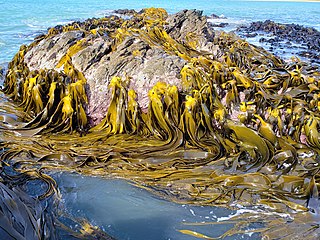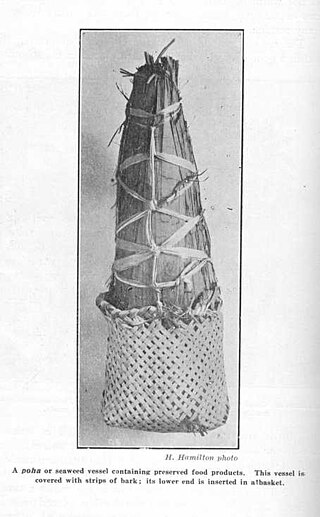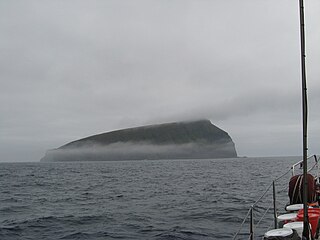
Kelps are large brown algae or seaweeds that make up the order Laminariales. There are about 30 different genera. Despite its appearance, kelp is not a plant but a stramenopile, a group containing many protists.

Megadyptes is a genus of penguins from New Zealand.

Nereocystis is a monotypic genus of subtidal kelp containing the species Nereocystis luetkeana. Some English names include edible kelp, bull kelp, bullwhip kelp, ribbon kelp, bladder wrack, and variations of these names. Due to the English name, bull kelp can be confused with southern bull kelps, which are found in the Southern Hemisphere. Nereocystis luetkeana forms thick beds on subtidal rocks, and is an important part of kelp forests.

The biodiversity of New Zealand, a large island country located in the south-western Pacific Ocean, is varied and distinctive. The species of New Zealand accumulated over many millions of years as lineages evolved in the local circumstances. New Zealand's pre-human biodiversity exhibited high levels of species endemism, but has experienced episodes of biological turnover. Global extinction approximately 65 Ma resulted in the loss of fauna such as non-avian dinosaurs, pterosaurs and marine reptiles e.g. mosasaurs, elasmosaurs and plesiosaurs. The ancient fauna is not well known, but at least one species of terrestrial mammal existed in New Zealand around 19 Ma. For at least several million years before the arrival of human and commensal species, the islands had no terrestrial mammals except for bats and seals, the main component of the terrestrial fauna being insects and birds. As recently as the 14th century a component has been introduced by humans, including many terrestrial mammals.

The Subantarctic snipe is a species of snipe endemic to New Zealand's subantarctic islands. The Maori call it "Tutukiwi". The nominate race C. a. aucklandica is found on the Auckland Islands. Other subspecies include C. a. meinertzhagenae from the Antipodes Islands, and C. a. perseverance from Campbell Island / Motu Ihupuku. The former subspecies from the Snares Islands has been separated as a full species, the Snares snipe, as have the extinct South Island and North Island snipes.

Durvillaea is a genus of large brown algae in the monotypic family Durvillaeaceae. All members of the genus are found in the southern hemisphere, including Australia, New Zealand, South America, and various subantarctic islands. Durvillaea, commonly known as southern bull kelps, occur on rocky, wave-exposed shorelines and provide a habitat for numerous intertidal organisms. Many species exhibit a honeycomb-like structure in their fronds that provides buoyancy, which allows individuals detached from substrates to raft alive at sea, permitting dispersal for hundreds of days over thousands of kilometres. Durvillaea species have been used for clothing, tools and as a food source by many indigenous cultures throughout the South Pacific, and they continue to play a prominent role in Chilean cuisine.

Durvillaea antarctica, also known as cochayuyo and rimurapa, is a large, robust species of southern bull kelp found on the coasts of Chile, southern New Zealand, and Macquarie Island. D. antarctica, an alga, does not have air bladders, but floats due to a unique honeycomb structure within the alga's blades, which also helps the kelp avoid being damaged by the strong waves.

Durvillaea willana is a large species of southern bull kelp endemic to New Zealand.

Onithochiton neglectus neglectus is a subspecies of chiton in the family Chitonidae.
The 1855 Wairarapa earthquake occurred on 23 January at about 9.17 p.m., affecting much of the Cook Strait area of New Zealand, including Marlborough in the South Island and Wellington and the Wairarapa in the North Island. In Wellington, close to the epicentre, shaking lasted for at least 50 seconds. The moment magnitude of the earthquake has been estimated as 8.2, the most powerful recorded in New Zealand since systematic European colonisation began in 1840. This earthquake was associated with the largest directly observed movement on a strike-slip fault, maximum 18 metres (59 ft). This was later revised upward to about 20 m (66 ft) slip, with a local peak of 8 m (26 ft) vertical displacement on lidar studies. It has been suggested that the surface rupture formed by this event helped influence Charles Lyell to link earthquakes with rapid movement on faults.

Onchidella marginata is a species of air-breathing sea slug, a shell-less marine pulmonate gastropod mollusk in the family Onchidiidae.

Durvillaea poha is a large, robust species of southern bull kelp found in New Zealand.
Durvillaea amatheiae is a large, robust species of southern bull kelp found in Australia.

Durvillaea incurvata is a large, robust species of southern bull kelp endemic to Chile.

Durvillaea chathamensis is a large, robust species of southern bull kelp endemic to the Chatham Islands of New Zealand.

Durvillaea potatorum is a large, robust species of southern bull kelp found in Australia.

Pōhā are traditional Māori bags made from southern bull kelp, which are used to carry and store food and fresh water, to propagate live shellfish, and to make clothing and equipment for sports. Pōhā are especially associated with Ngāi Tahu, who have legally recognised rights for harvesting source species of kelp.

Pyrophyllon subtumens is an obligate red algal epiphyte of Durvillaea southern bull-kelp, and is endemic to New Zealand.

Maullinia is a genus of intracellular, phytomyxid parasites found across the Southern Hemisphere though primarily in Chile, The Prince Edward Islands, South Africa, Australia, and New Zealand. These parasites infiltrate the cells of their brown algal hosts via cytoplasmic extensions called plasmodia that divide synchronously, becoming increasingly multi-nucleate and engulfing the host cell organelles as they grow. Eventually, as the plasmodia fill the entire cell volume, the host cells become hypertrophied and grow to 3- 4x their original size, showing up as swollen appendages or galls on the host tissue at a macroscopic level. These swollen regions will burst alongside the mature Maullinia plasmodia, releasing biflagellated zoospores to the inter- and extracellular space to disperse the infection further. Zoospores can come from sporangial plasmodia, as in M. ectocarpii, or from resting spores, as in M. braseltonii.

Moutere Mahue / Antipodes Island Marine Reserve is a marine reserve covering an area of 217,287 hectares around the Antipodes Islands south of New Zealand's South Island and Stewart Island / Rakiura. It was established in 2014 and is administered by the New Zealand Department of Conservation.


















